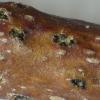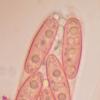
20-12-2025 23:08
Patrice TANCHAUDBonsoir, récolte sur sol sablonneux dans l'arri�

21-12-2025 09:32
Hello.A tiny ascomycete found embedded in wood in

20-12-2025 15:47
Mirek GrycHi.These grew on pine wood that was heavily covere

18-12-2025 21:17
Pol DebaenstThe identification took me to Byssonectria deformi

15-12-2025 07:09
 Danny Newman
Danny Newman
indet. Rutstroemiaceae sp. on unk. fallen leavesMc

19-12-2025 10:10
Patrice TANCHAUDBonjour, récolte réalisée en milieu dunaire, a

18-12-2025 17:23
 Bruno Coué
Bruno Coué
Bonjour,je serais heureux d'avoir votre avis sur c
Prosthecium platanoidis
Andgelo Mombert,
21-04-2020 20:14

Bonsoir,
Sur brindille morte d'Acer pseudoplatanus. Pouvez-vous me confirmer Prosthecium platanoidis ?
Ascospores : 23-35 x 7-10 µm, cylindro-elliptiques, triseptées, rétrécies au niveau des cloisons, avec des éperons aigus peu visibles aux extrémités, hyalines, guttulées, lisses.
Asques : cylindriques, octosporés. Je n'ai pas remarqué d'appareil apical clairement congophile.
Merci d'avance !
Andgelo
Enrique Rubio,
21-04-2020 20:21
Re : Prosthecium platanoidis
Bonsoir Andgelo
Prosthecium platanoidis semble être une espèce américaine qui n'est pas congénerique avec celle-ci. Le nom correct de votre champignon semble être Calosporella innesii.
Prosthecium platanoidis semble être une espèce américaine qui n'est pas congénerique avec celle-ci. Le nom correct de votre champignon semble être Calosporella innesii.
Yannick Mourgues,
21-04-2020 20:30

Re : Prosthecium platanoidis
Bonjour.
Oui, Enrique, que je salue, a raison.
Tu pourras lire la description de Calosporella innesii dans Mycological research 112 (2008) cette note :
Notes — Calosporella innesii is characterised by hyaline,
mostly 3-septate ascospores with small apical appendages
and has been transferred to Prosthecium by Wehmeyer (1941)
based on its phragmospores with apical appendages. This
generic classification has subsequently been commonly followed.
Barr (1978) argued that the correct epithet for the taxon
should be Prosthecium platanoidis due to priority, but the type
collection of this species is apparently not congeneric with the
current fungus (see notes above). The name to be applied for
the species is therefore C. innesii.
In the original description, Currey (1858) did not provide any
details about collections. There are numerous authentic collections
of the Currey herbarium in K, one of which is here
selected as lectotype. To ensure nomenclatural stability, a
recent well-developed specimen for which a culture is available
is here selected as epitype. The appendages can be seen well
in water mounts even from old herbarium specimens, but they
quickly disappear in KOH mounts.
mostly 3-septate ascospores with small apical appendages
and has been transferred to Prosthecium by Wehmeyer (1941)
based on its phragmospores with apical appendages. This
generic classification has subsequently been commonly followed.
Barr (1978) argued that the correct epithet for the taxon
should be Prosthecium platanoidis due to priority, but the type
collection of this species is apparently not congeneric with the
current fungus (see notes above). The name to be applied for
the species is therefore C. innesii.
In the original description, Currey (1858) did not provide any
details about collections. There are numerous authentic collections
of the Currey herbarium in K, one of which is here
selected as lectotype. To ensure nomenclatural stability, a
recent well-developed specimen for which a culture is available
is here selected as epitype. The appendages can be seen well
in water mounts even from old herbarium specimens, but they
quickly disappear in KOH mounts.
Yannick Mourgues,
21-04-2020 20:32

Re : Prosthecium platanoidis
Et les appendices seront bien visibles avec un montage dans de l'encre de chine.
Andgelo Mombert,
21-04-2020 20:32

Re : Prosthecium platanoidis
Un grand merci à vous. J'ai bien fait de vous soumettre ce champignon ''à priori'' facile à reconnaître.
Je viens de lire l'article en question.
Merci encore !
Andgelo
Alain GARDIENNET,
21-04-2020 22:22
Re : Prosthecium platanoidis
Salut Andgelo,
Personnellement ça ne me gêne pas de l'appeler comme tu l'as fait.
Un des plus courants sur sycomore.
Alain
Andgelo Mombert,
22-04-2020 09:55

Re : Prosthecium platanoidis
Bonjour Alain,
Merci, mais quid de l'article cité ci-dessus ?
Andgelo
Alain GARDIENNET,
22-04-2020 14:40
Re : Prosthecium platanoidis
Oui bien sûr il faut le nommer Calosporella innesii, les collègues ont raison.





